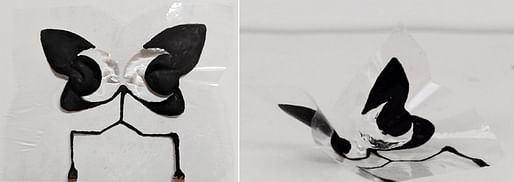

A team of designers and engineers at the University of Colorado Boulder’s ATLAS Institute have tapped into new advancements in the field of soft robotics to develop paper-thin, moveable mechanisms. The objects, dubbed “Electriflow”, which don’t require motors or other traditional machinery parts to function, have been presented at the Association for Computing Machinery’s 2021 Designing Interactive Systems (DIS) conference.
The researchers’ early creations include origami cranes that can bend their necks, moving flower petals, and fluttering insects.
“Usually, books about butterflies are static,” said CU Boulder graduate student and team lead, Purnendu. “But could you have a butterfly flap its wings within a book? We’ve shown that it’s possible.”
Electriflow took inspiration from previously developed “artificial muscles” by Christopher Keplinger at CU Boulder. His work is now available commercially through a company called Artimus Robotics. Keplinger employed a technology called hydraulically amplified self-healing electrostatic (HASEL) actuators, which get their power from fluids. They rely on electrostatic forces to push oil through sealed plastic pouches. The mechanics are similar to that of a ketchup packet whose shape changes when one side is squeezed. They also mirror the behaviors of the natural environment, in which organisms change their shapes to fend off predators or trap prey.
“One of the main benefits of these actuators is that they’re versatile,” said Eric Acome, a former CU Boulder graduate student who helped pioneer the actuator technology. “They’re just pouches, but depending on the shape of that pouch, you can generate different kinds of movement.”
With more than just robotics in mind, Purnendu used Artimus Robotics’ concept to design soft, moveable artwork. Electriflow uses several different pouch shapes to create origami-like folds in flat plastic sheets. The results are incredibly fast-moving objects. His butterflies can beat their wings at a top speed of approximately 25 beats per second, which is quicker than most real butterflies.
“This system is very close to what we see in nature,” Purnendu said. “We’re pushing the boundaries of how humans and machines can interact.”
“There are a lot of different geometries that we can play with,” he added.
The researcher hopes more artists and designers will use this concept to push the boundaries further.
No Comments
Block this user
Are you sure you want to block this user and hide all related comments throughout the site?
Archinect
This is your first comment on Archinect. Your comment will be visible once approved.